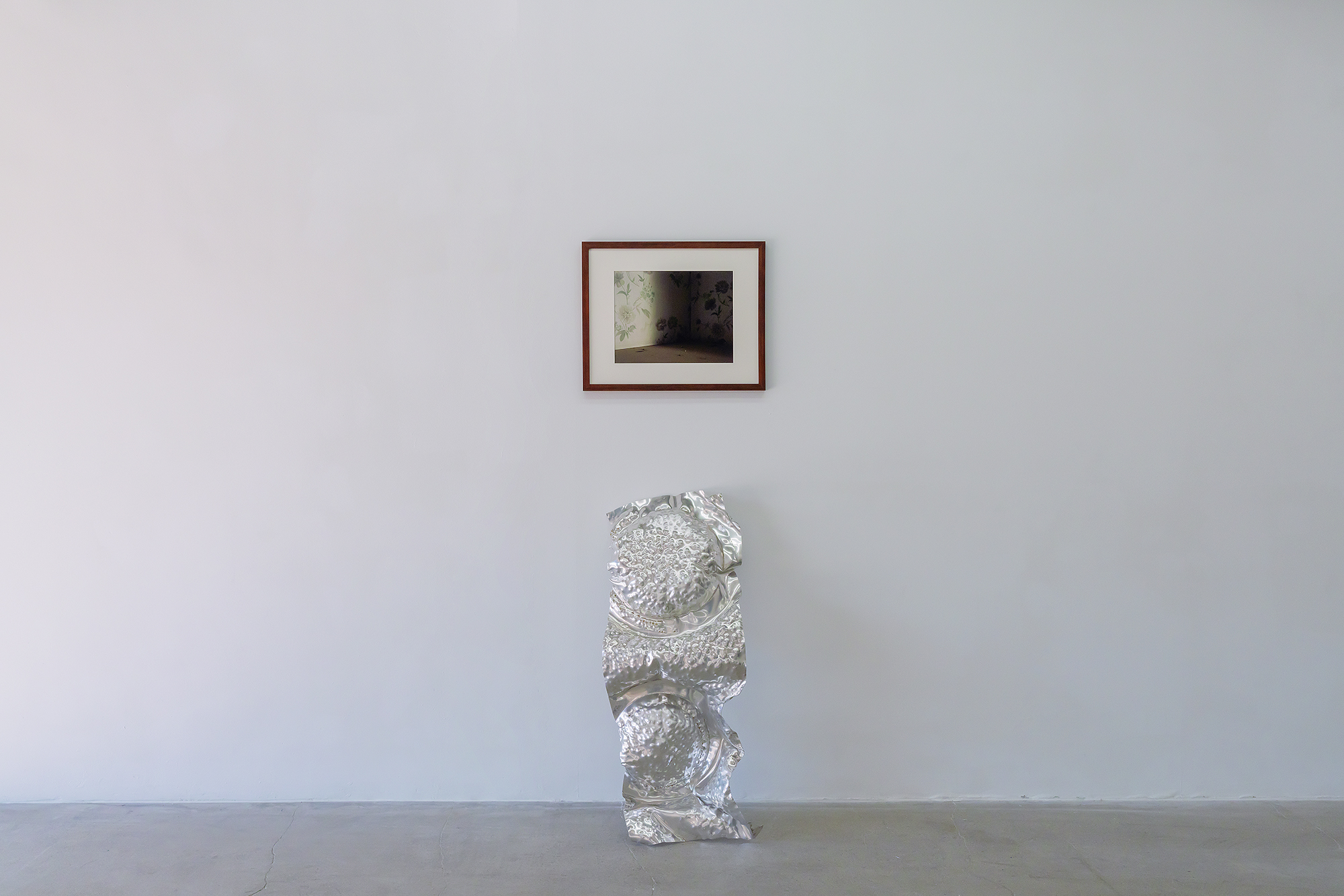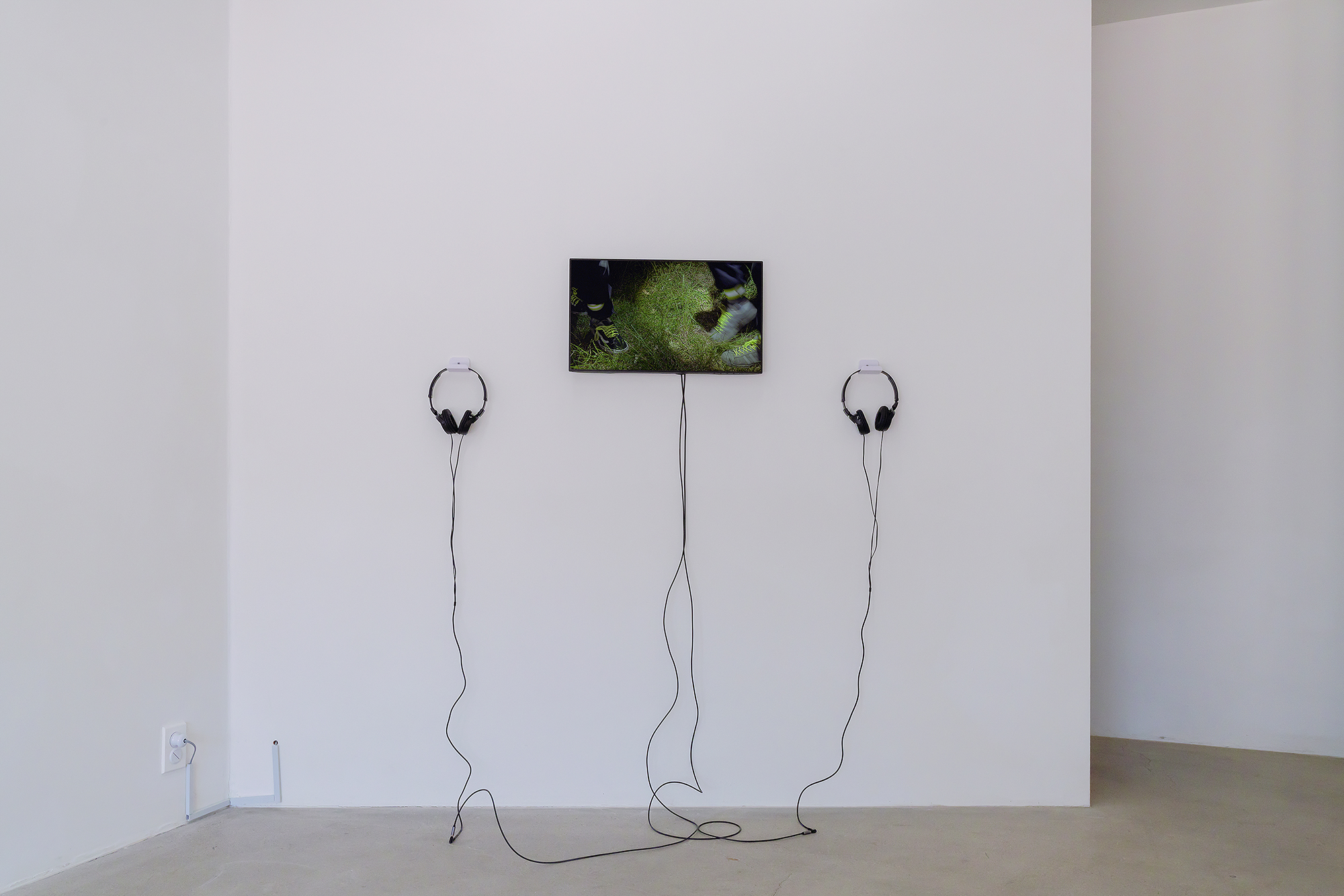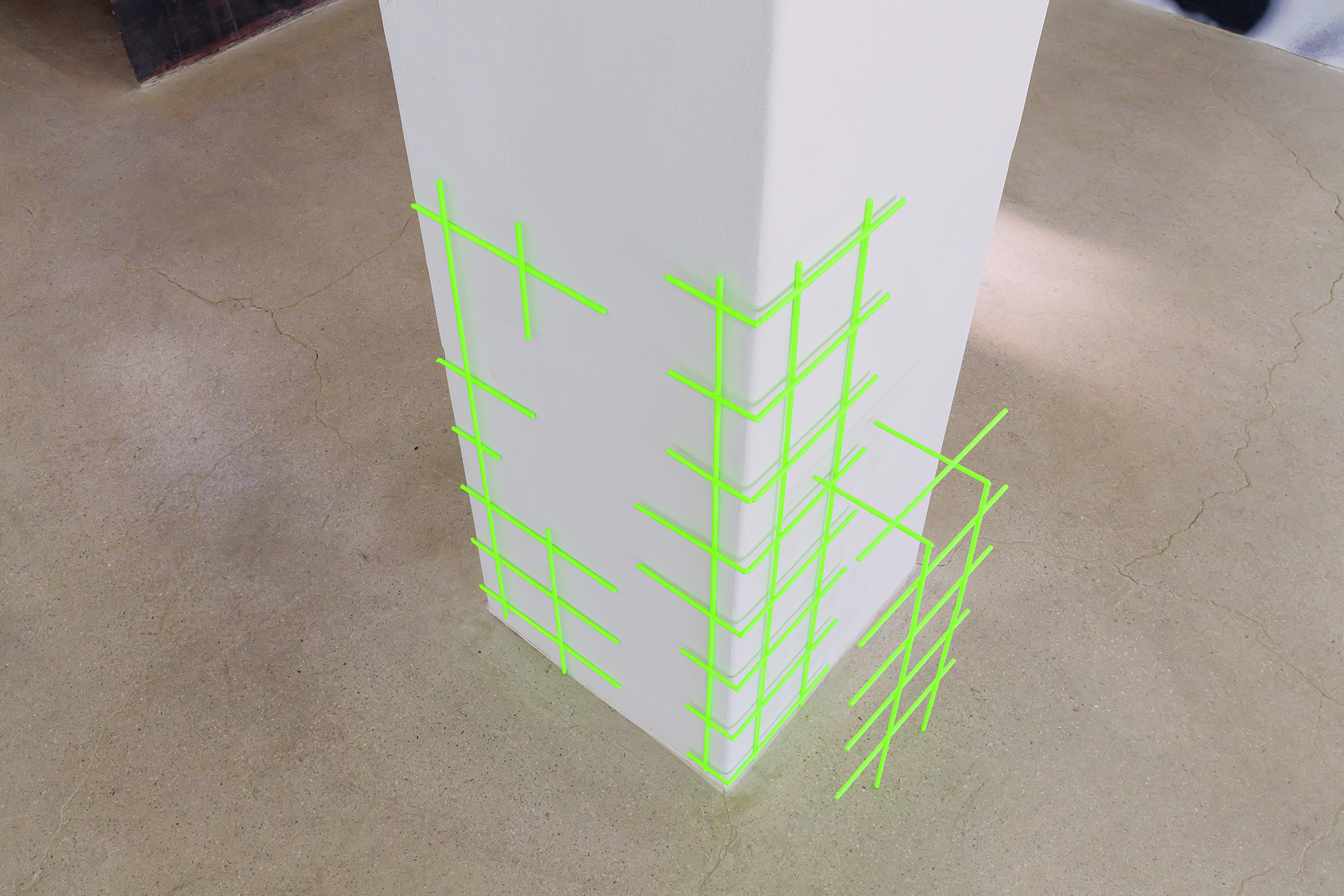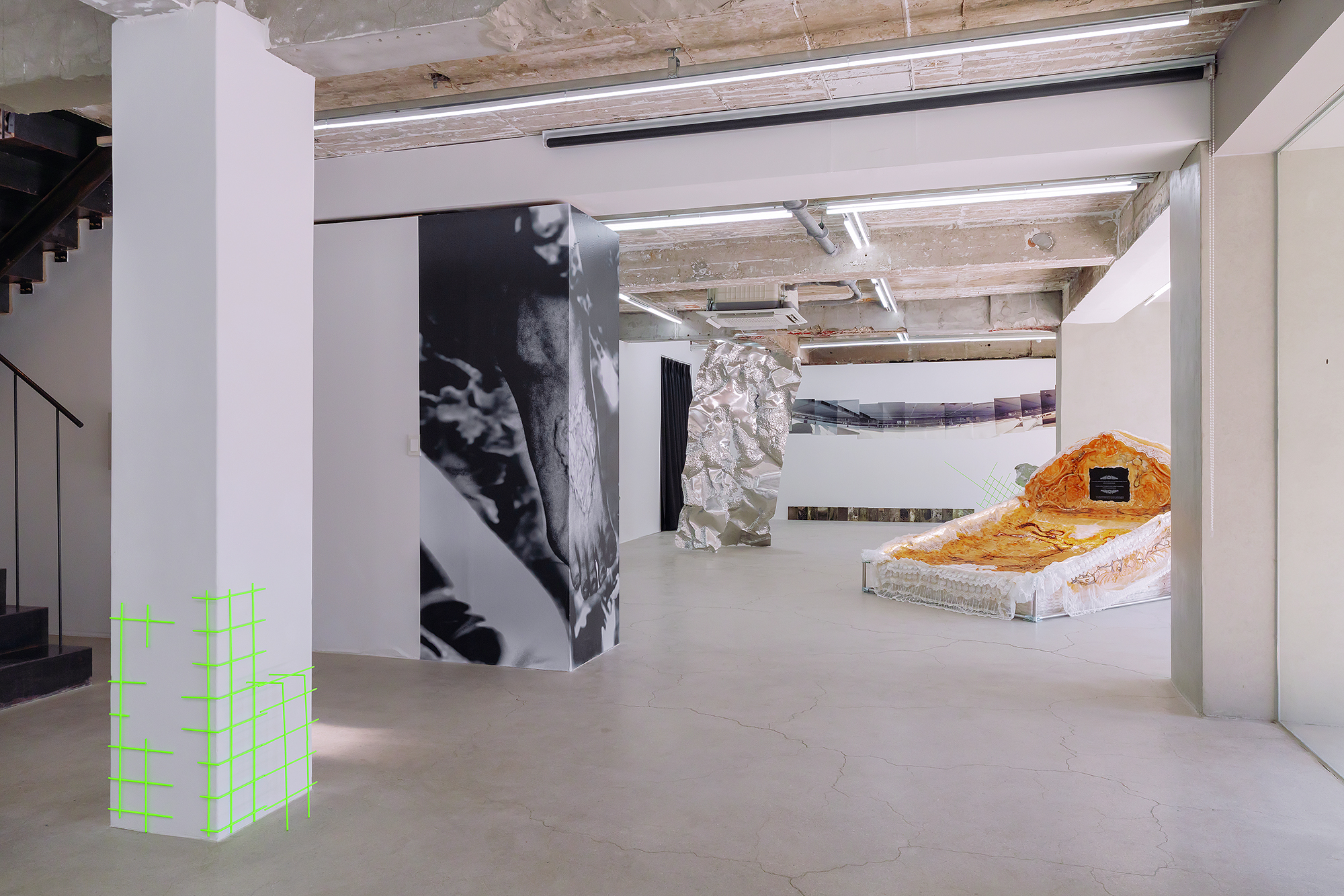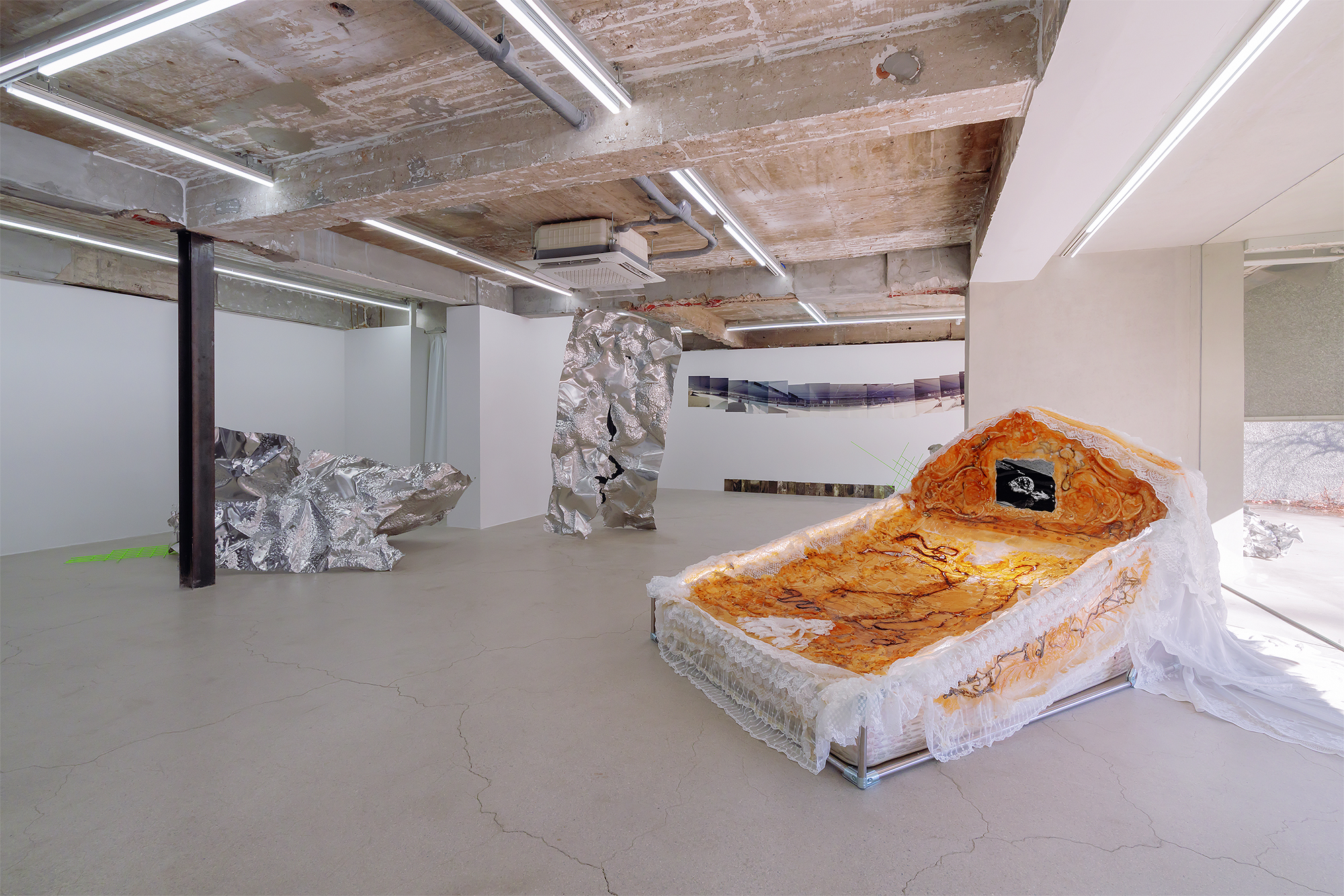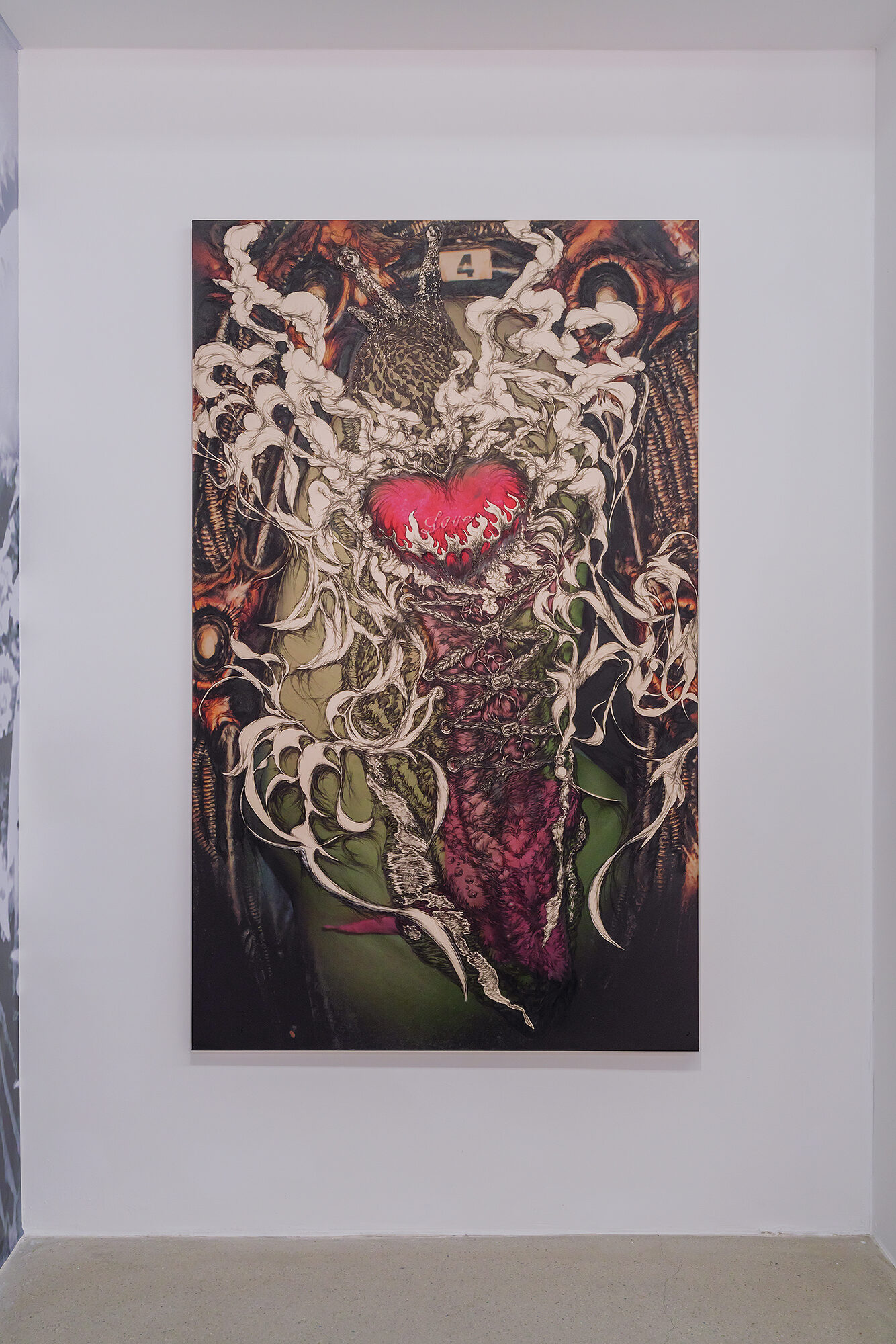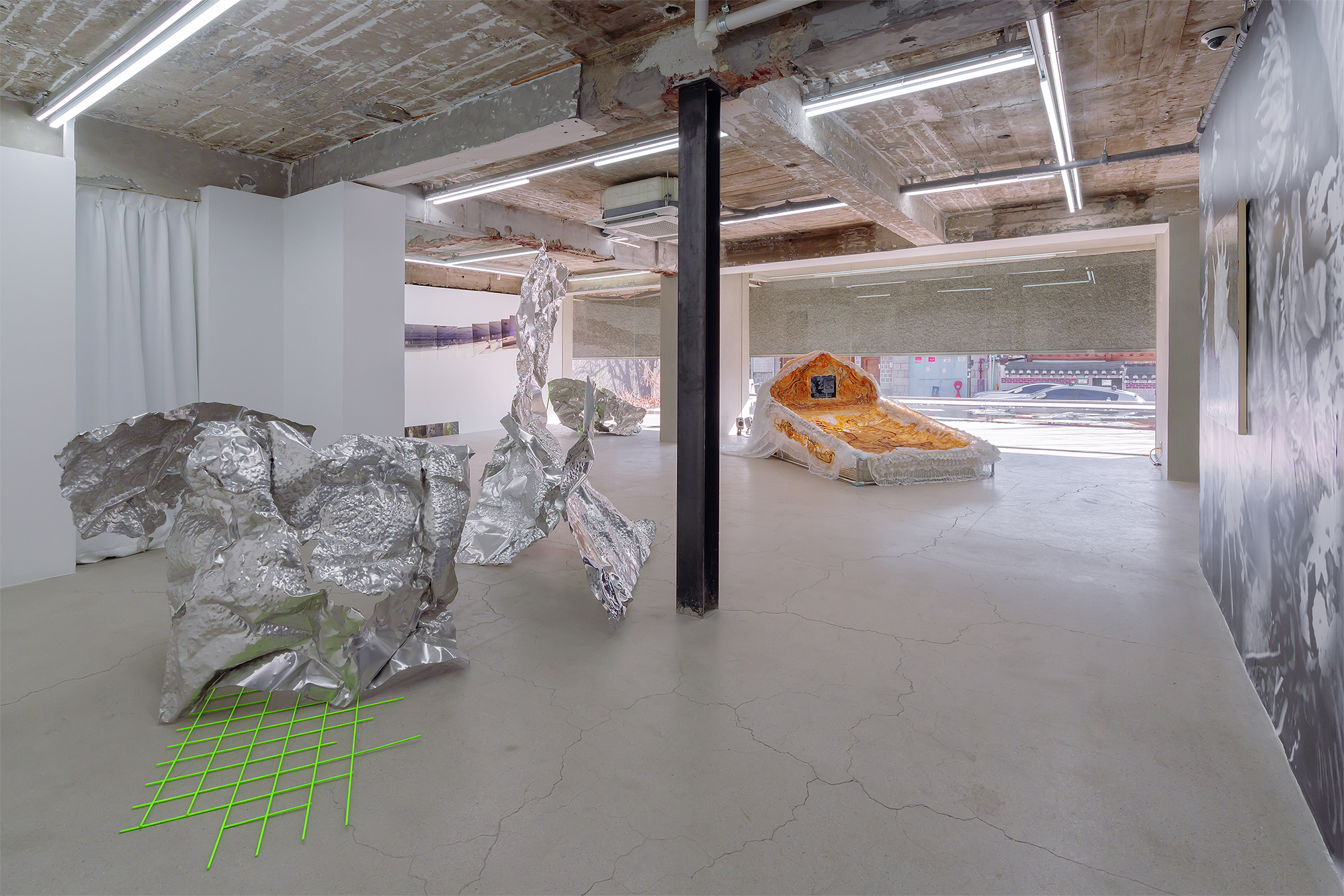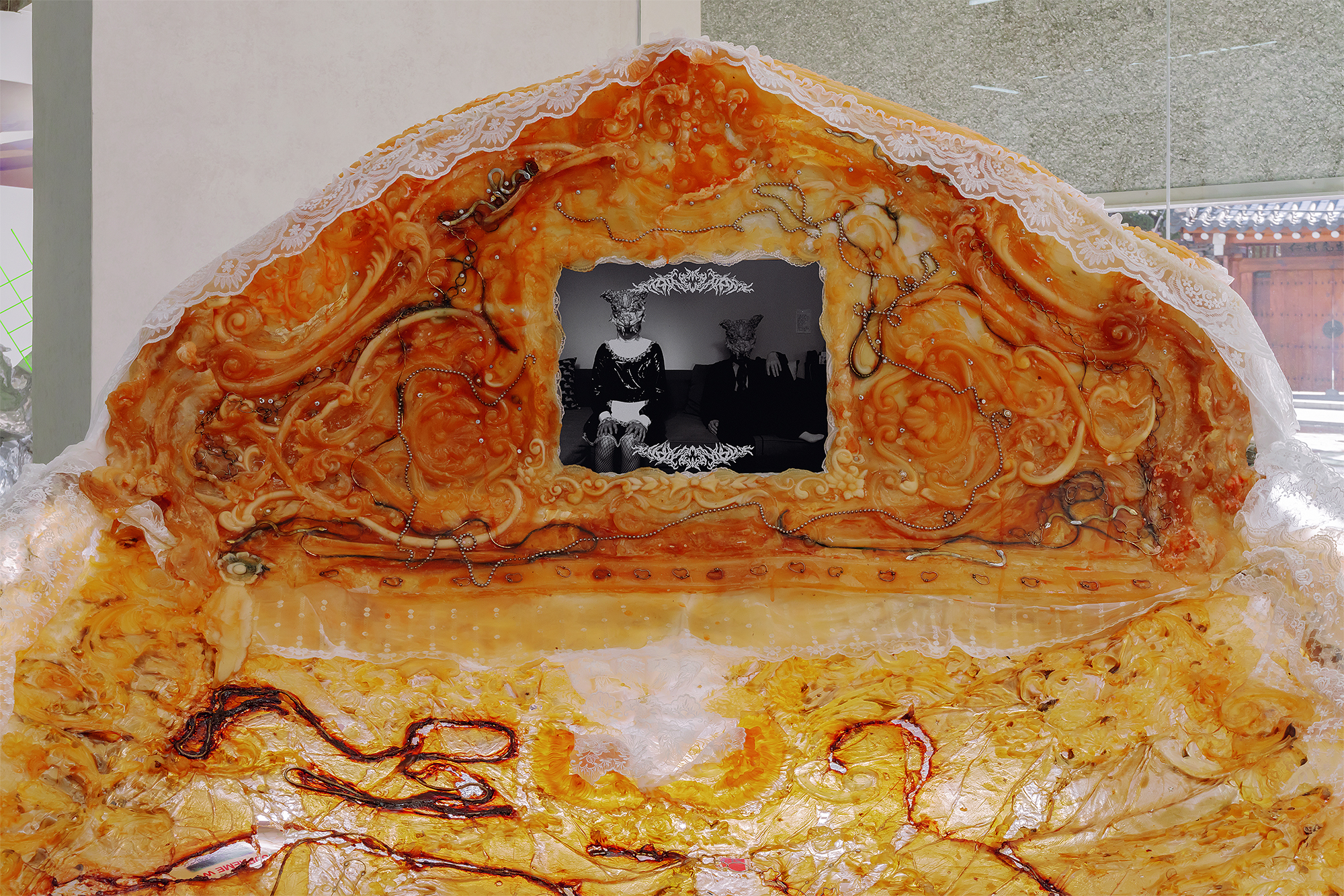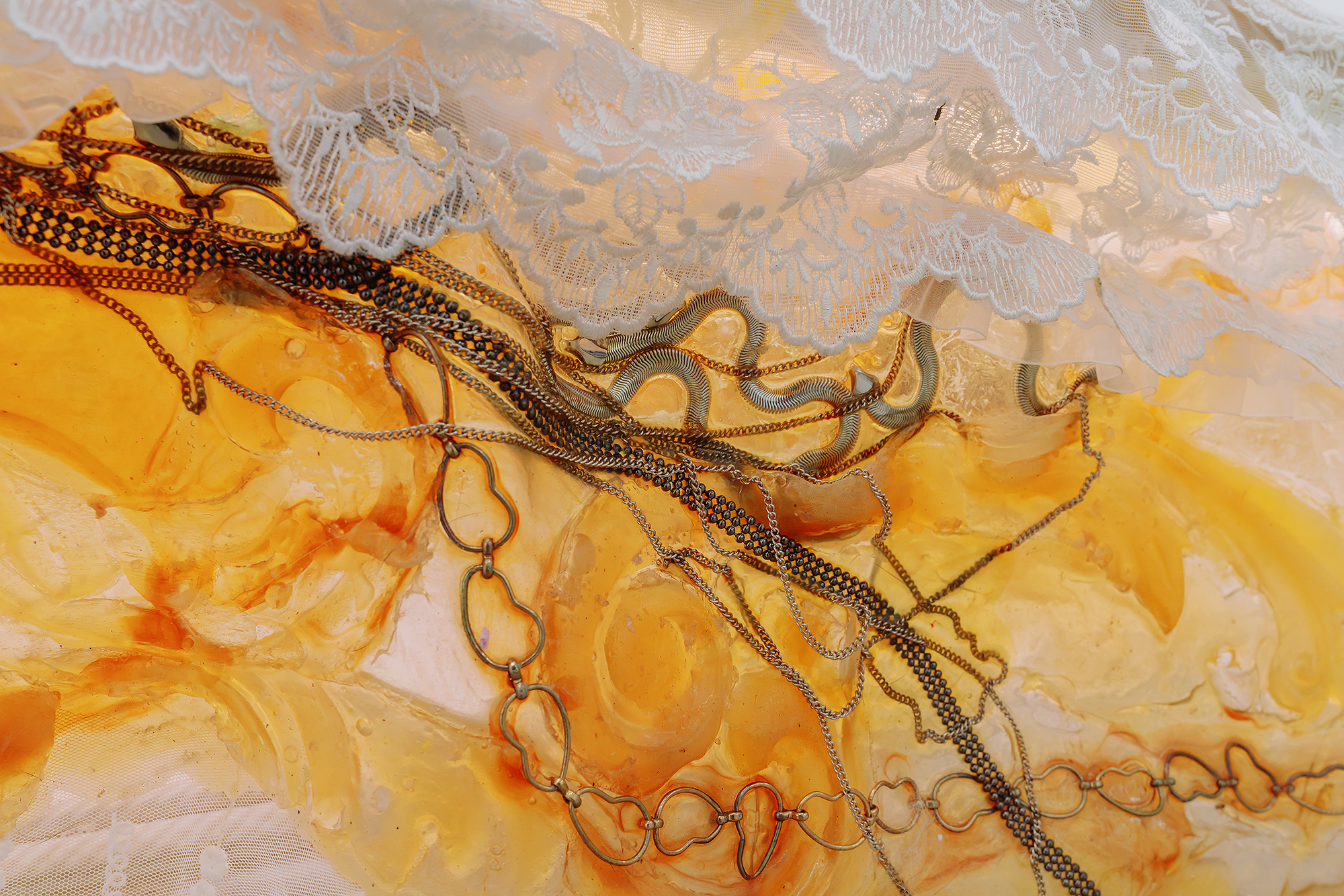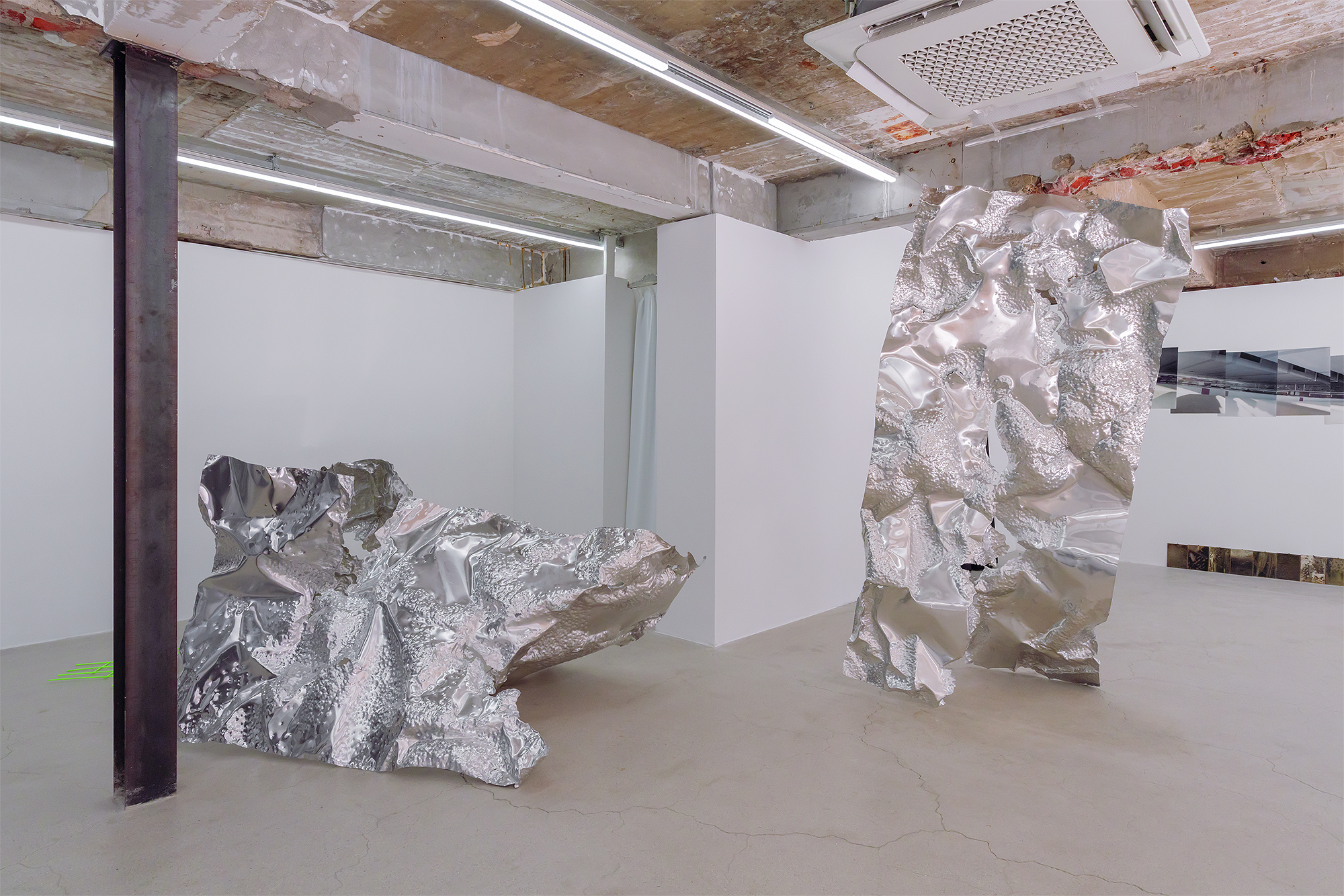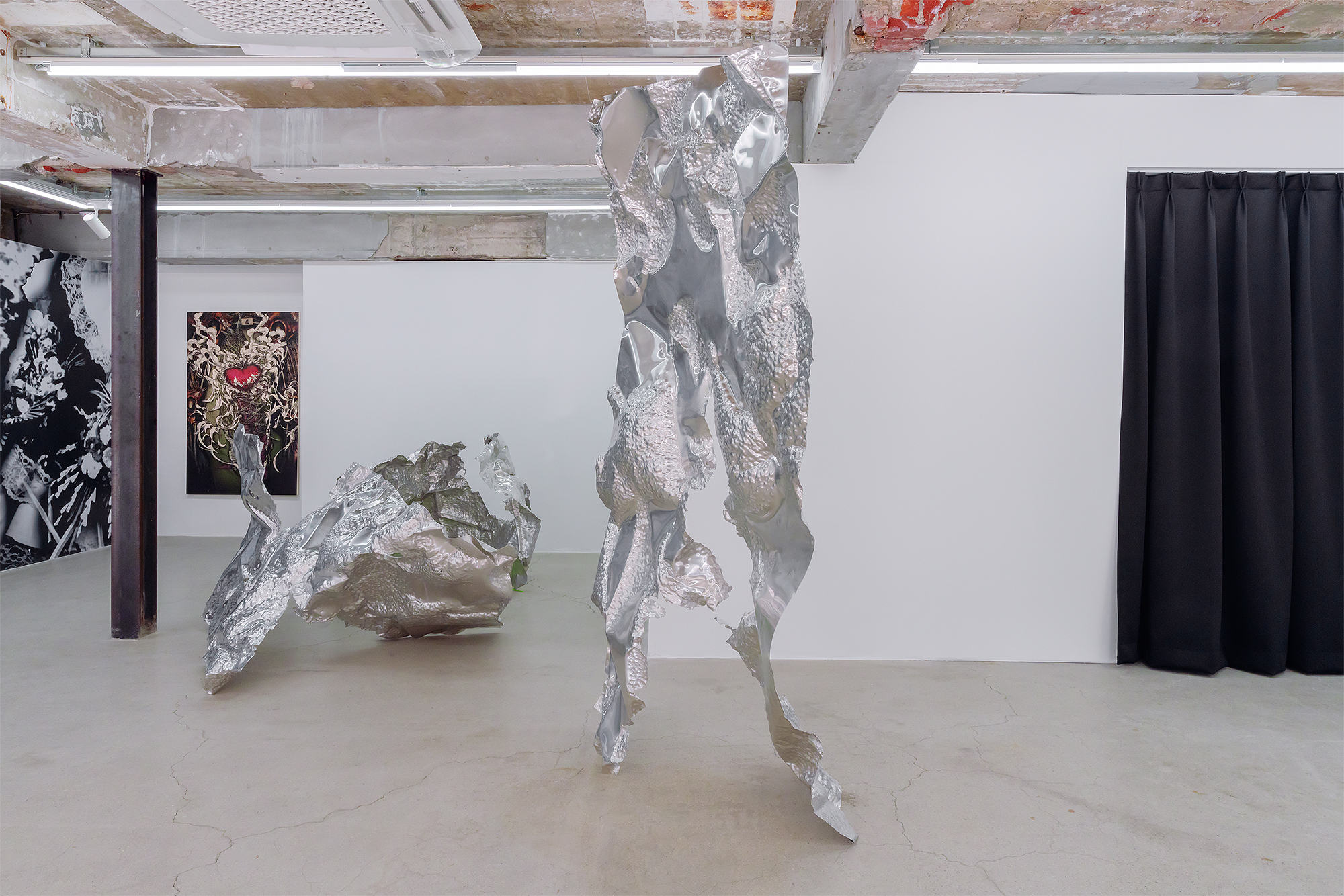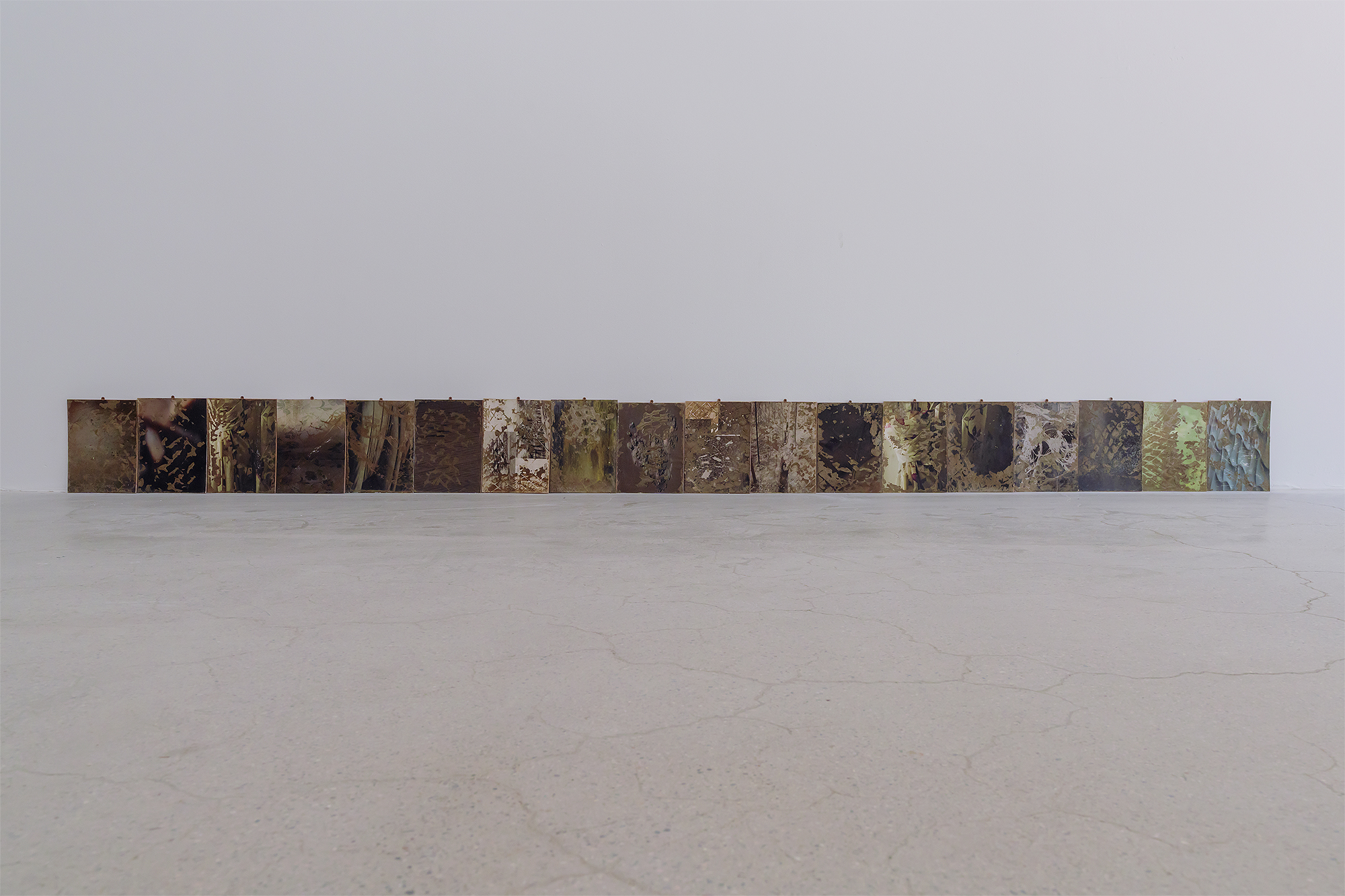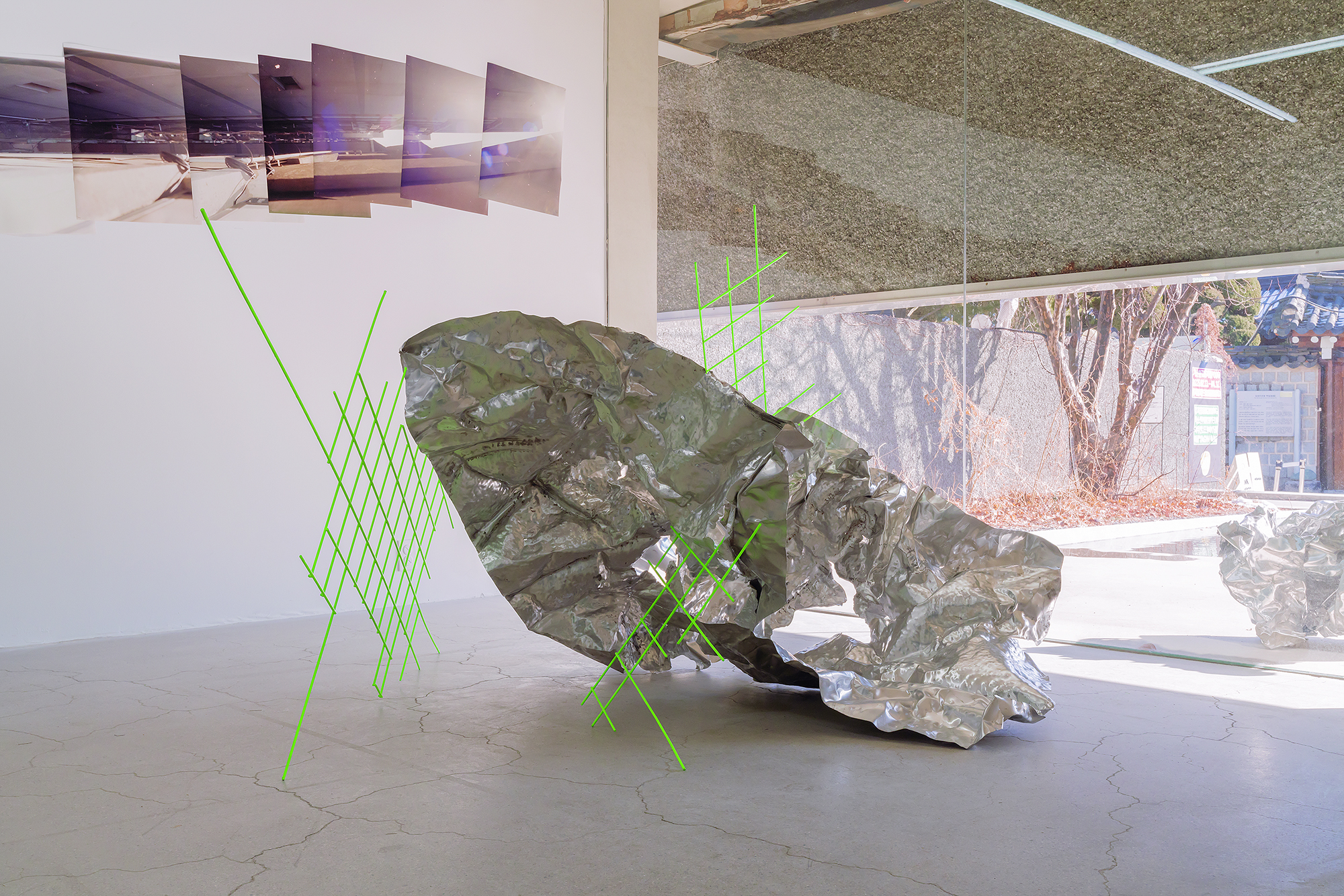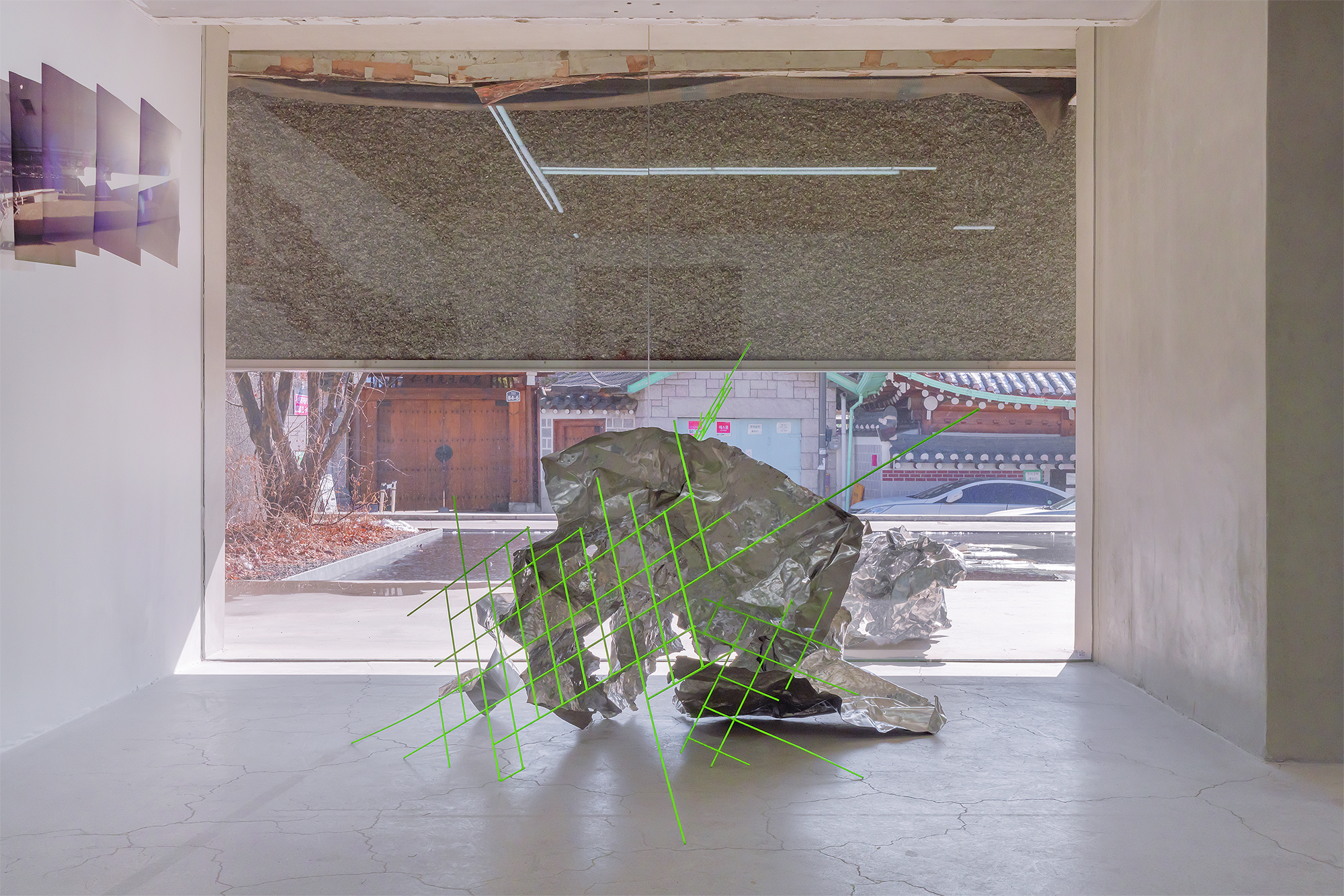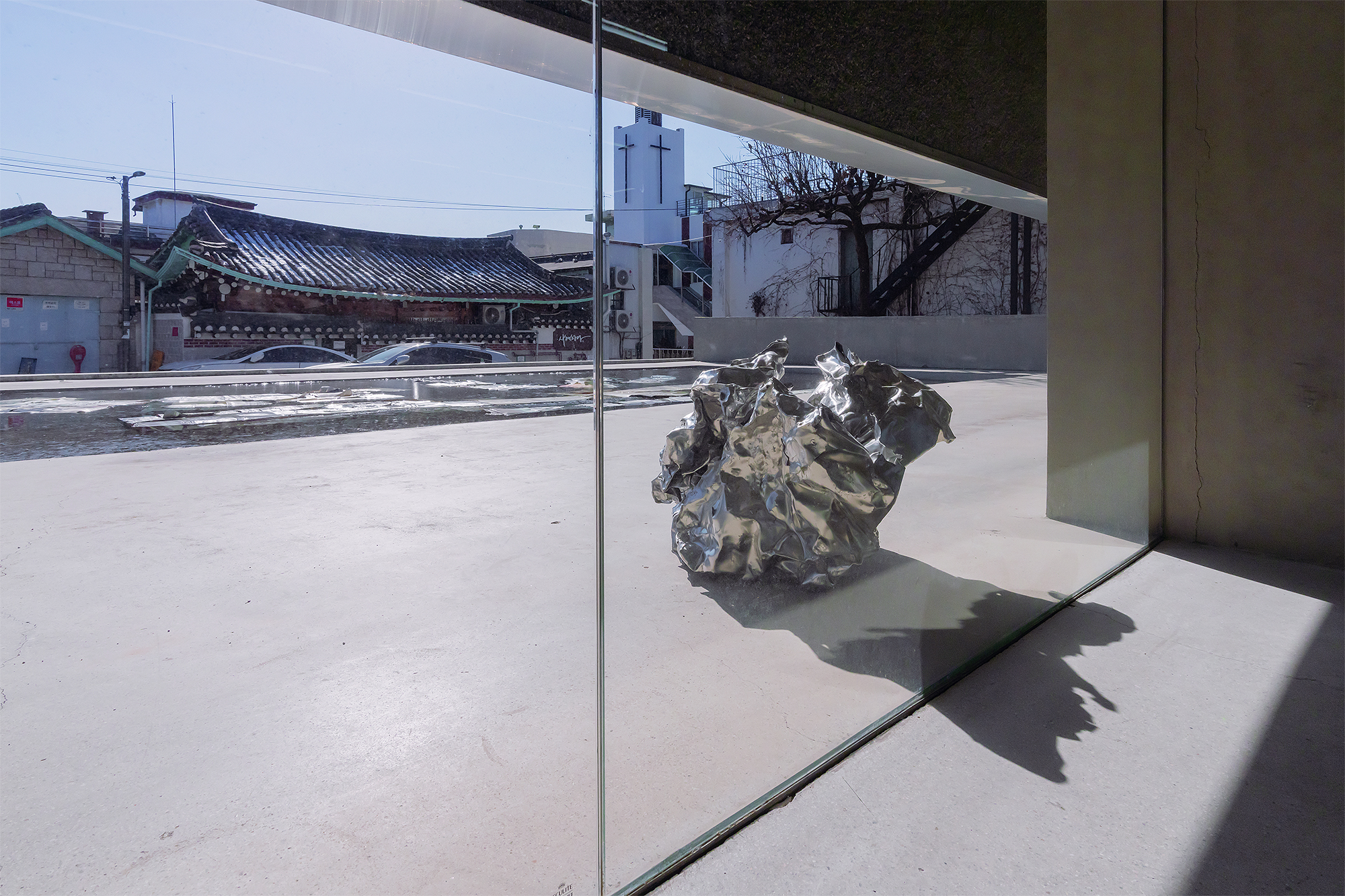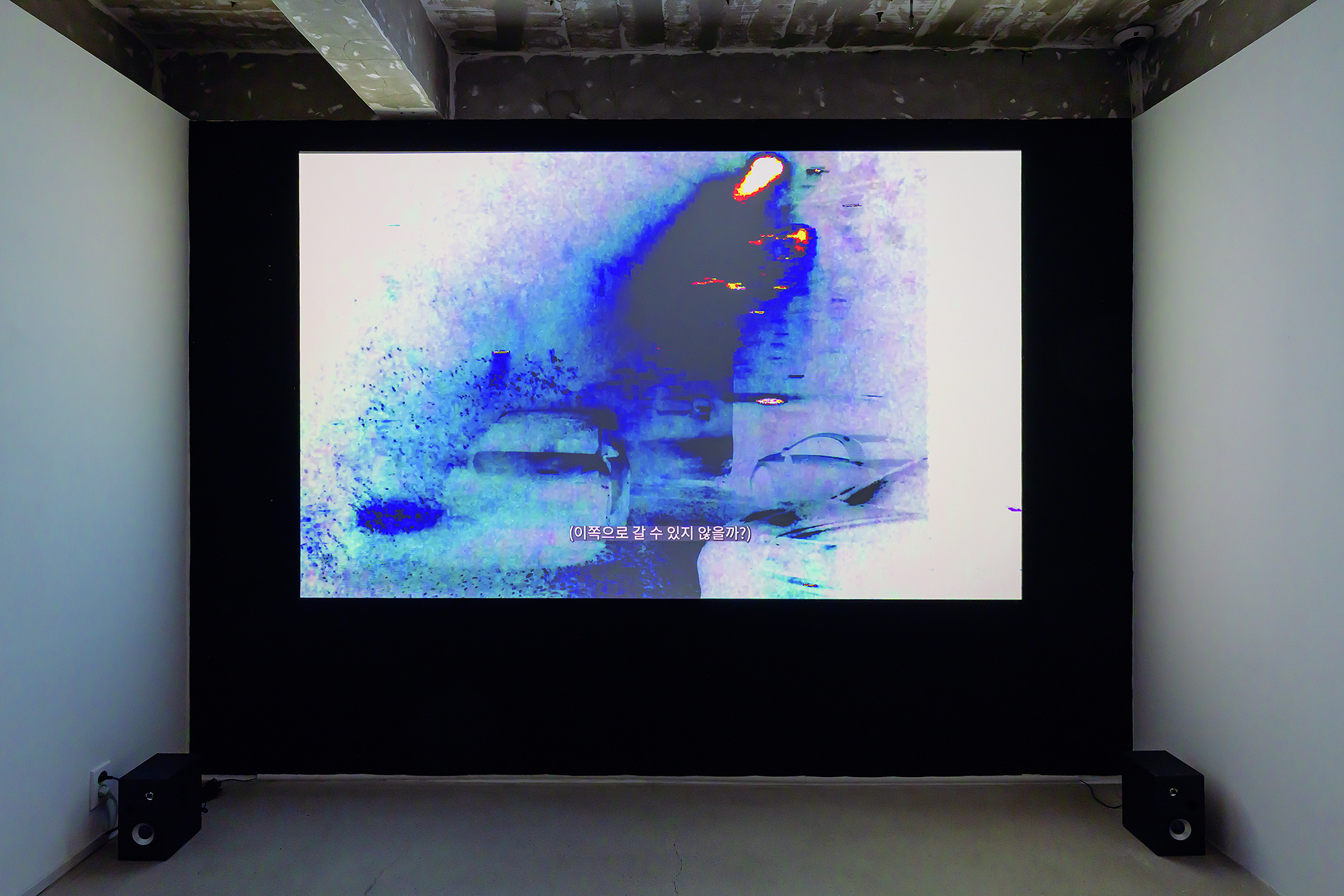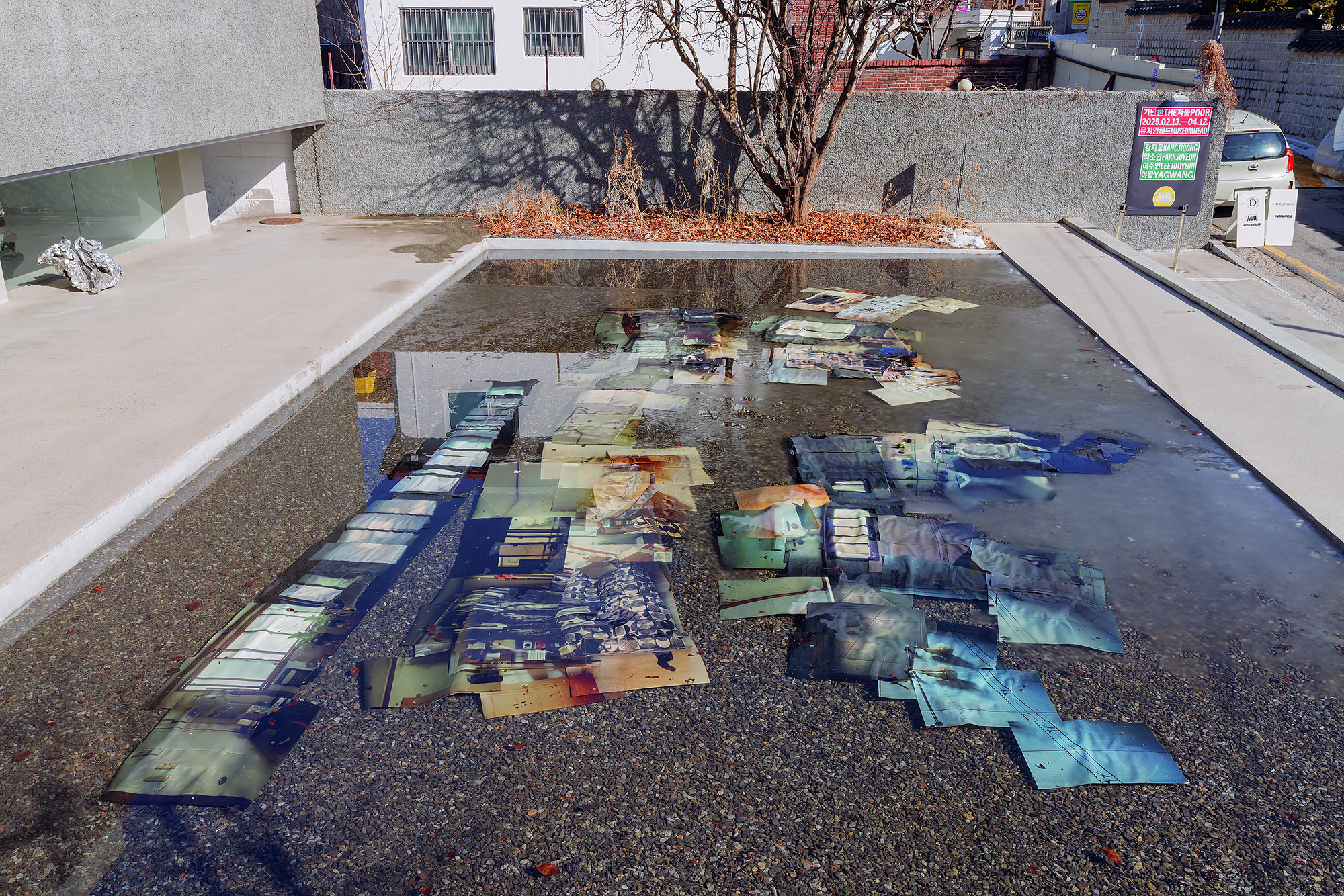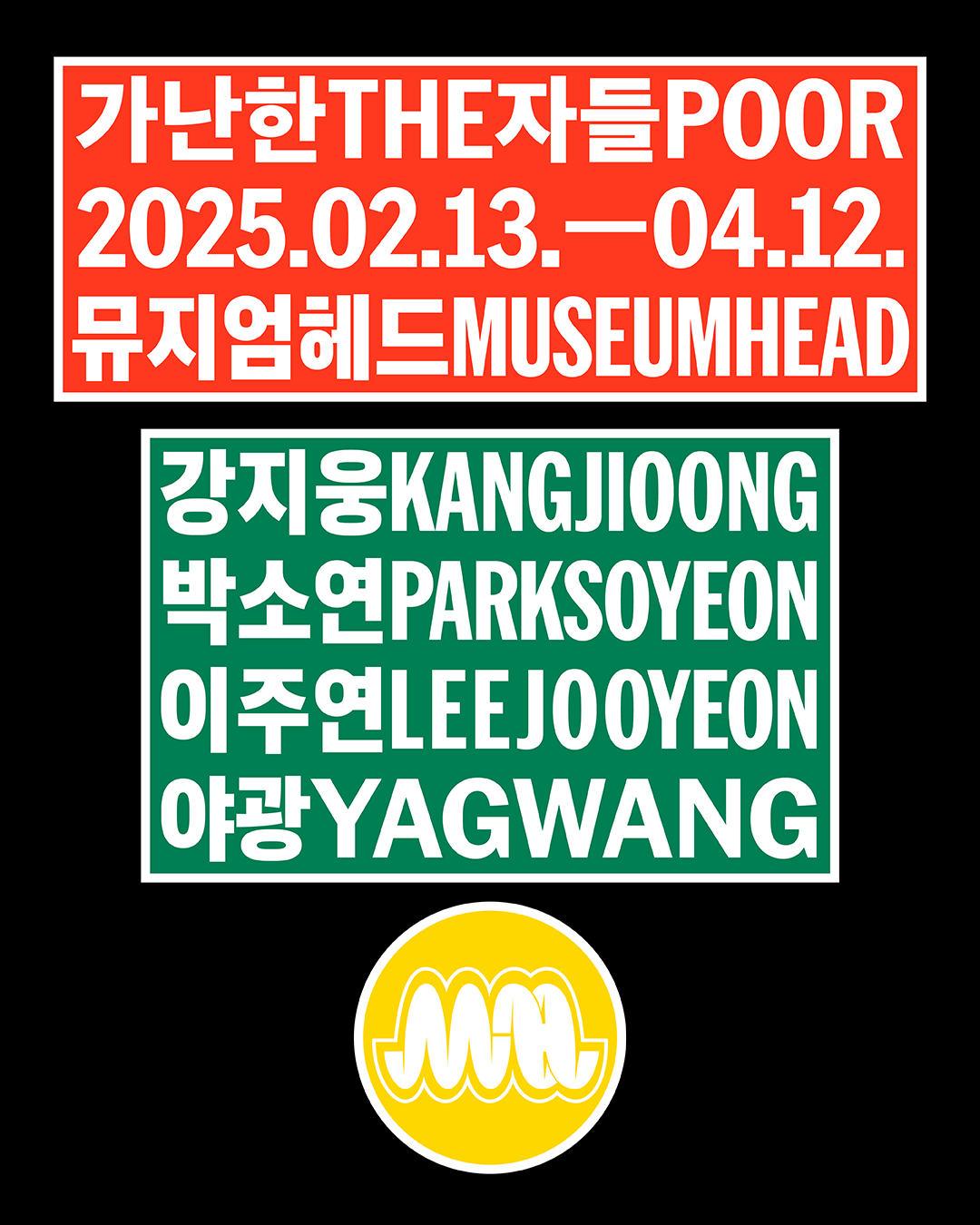《가난한 자들》
강지웅 박소연 이주연 야광
25.02.13.-04.12.
12:00-19:00 (일, 월 휴관)
서울시 종로구 계동길 84-3, 1층 뮤지엄헤드
기획: 허호정
그래픽 디자인: A Studio A (이재환)
설치: 김병찬
주최, 주관: 뮤지엄헤드
후원: 한국문화예술위원회
The Poor
KANG Jioong, LEE Jooyeon, PARK So Yeon, Yagwang
25.02.13.-04.12
12:00-19:00 (closed on Sun, Mon)
Curated by HUR Hojeong
Graphic Design by A Studio A
Technical Support KIM Byungchan
Hosted and Organised by Museumhead
Supported by Arts Council Korea
- 본 전시는 “한국문화예술위원회 2025 시각예술창작주체” 지원금의 지원을 받아 운영되었습니다.
가난한 자들은 누구인가? 그들은 어디에 있는가? 착취에 저항하는 기존의 계급 개념은 사라지고, (유사) 자율적 주체, 계약과 협정을 맺은 개인들만이 남아있다. 심지어 사람들은 저마다 스스로가 (더) 가난하다고 느낀다. 당장의 부족함과 소유의 (불) 가능성이 시시때때로 결핍을 상대화할 때, 가난한 자들의 정체와 존재는 더욱 모호해진다. 하지만 모호한 인식 저편에 실질적으로 그 계급에 처한 이들이 있고, 누군가는 골방, 거리, 한강 다리 언저리에 머물며, 어쩌면 누군가는 울분에 차 양손에 깃발을 들고 화환을 세우며 소리를 지르기도 한다.
상실된 계급과 만연한 결여의 정서 사이에서, 가난한 자들을 떠올리고 말하기는 가능한 것일까? 감히 미술이 가난을 말할 수 있을까? 전시 《가난한 자들》에 드리워진 감각은 매끈하지 않은 것, 버려질 것, 노이즈에 가까운 것이다. 임시적이고 반응적이며 말초적인 차원에서 작품이 만들어진다. 값싼 재료를 이용하는 미술, 부서지고 마모되어 소멸하는 미술, 당장 내가 누울 잠자리를 고민하는 만큼 만들어지고 난 뒤의 소재지를 고민해야 하는 미술들…. 그 어떤 결여가 초과와 잉여로써 형식화된다. 전시는 동시대 서울 미술 현장에서 목도한 특정한 태도/형식을 “가난한 미술”로 호명해 본다. 그리고 그것이 어디를 바라보고, 무엇을 말하고 있는지 들여다보며 모종의 집단성, 시대의 증후적 공통감을 발견하려 한다.
일찍이 히토 슈타이얼은 “가난한 이미지(poor image)”(2012)를 개념화하며, 디지털 기반의 매체 조건 하에 창궐한 복제 이미지, 열화되어 데이터 값이 충분치 않은 빈약한 상태의 이미지를 고려했다. 그리고 ‘가난한 이미지’의 속도와 비물질성에서 가능성을 보는 동시에 그 같은 성질이 모든 것을 데이터화(/상품화)하여 통제하는 생정치(/소비주의)에 활용될 위험 역시 상기했다. 하지만 지금에 와서 그 개념을 강조하는 일이 새삼스럽고 낯뜨겁기까지 한 이유는, 오늘날 많은 미술—가난함의 역학을 사고하는 임무를 부여받았던 미술—이 ‘가난한 이미지’를 자연화하는 데 머물기 때문이다. 이제 미술은 모니터 안에서 부유하는, 무한한 소비재로서 재생되는 이미지 일반과 다름없어진다. 그리고 그러한 현상에 의문을 제기하고 저항하기는커녕 그것이 자연스럽다는 듯이 군다. 매끈한 화면(브러시 스트로크가 웬 말인가!), 소유욕을 자극하는 오브제가(오브제에 다름 아닌 작품이) 곳곳의 전시장을 채우고, 이미지의 비물질화가 가속화된다.
이때, 이번 전시에서 호명된 “가난한 미술”은 후기 자본주의 시대에 급속도로 ‘자연화한’ 가난한 이미지에 제동을 걸거나 적어도 난처해한다. 강지웅, 박소연, 이주연, 콜렉티브 야광, 네 명/팀의 작가들은 현재의 매체 조건 안에서 발생하는 이미지의 빈곤함을 체화하고, 나아가 이를 급진적으로 재사유한다. 이들은 공통적으로 열화 · 오염 · 파손을 작업의 과정 안에 포함하는 동시에 그것을 물질의 두께로 현실화한다. 그리하여 소장 · 보존을 기약하지 못하는, 그러나 이미지 일반을 넘어서는 물질, ‘가난한 미술‘을 선보인다. 그리고 불안하게 현재의 전시장을 점유하려 한다.
나아가, 이들 네 명/팀의 작가들에게서는 공통적으로 후기 자본주의 시대에 나고 자란 이들이 체득한 불안정성이 증후적으로 발견된다. 그리고 그 불안정성은 부정되기보다 긍정되고 초월된다. 의지할 곳 없음, 옴짝달싹할 수 없음, 더 나아질 수 없음의 총체적인 불안정성 앞에서 ‘안정’을 추구한다면 가장 빠르게 당도하는 곳은 ‘포기와 우울’이다. 하지만 이를 일찌감치 체득한 청년들은 더 나빠지기만 하리라는 자포자기도, 조금 더 노력하면 안정에 도달하리라는 낙관도 서두르지 않으면서, 더욱 충만한 불안정성, 위계 없는 불안정성을 추구한다. 결핍으로부터 파생하고 빈곤에서 증식해 다른 방향으로 초과해버리는 과잉의 미학은 바로 이러한 태도와 궤를 같이한다.
강지웅은 사진의 손상을 예비함으로써 평평한 복제 이미지의 무한성 대신 유한한 물질의 두께를 확인시켜왔다. 가령, 〈무제(자국 스터디, 연작)〉(2024)는 곱게 인화된 기존의 작업물을 펄에 담가 오염시키고 밀물과 썰물이 남긴 자국을 그 자체 사진으로 형식화한 것이다. 해당 시리즈와 함께 작가는 출력된 이미지를 그 자체 또 다른 물질로 대하며 실험해왔다. 이로써 작가는 카메라 앞의 대상과 사진 이미지 사이의 거리를 넓히는 데 주력한 것으로 보인다.
이번 전시에서는 작가 자신이 사는 집을 대상 삼아 익숙한 장소에 타자화 된 거리를 확보하면서 기존의 실험을 이어 나간다. 작가는 혼자 지내기에 충분히 넉넉한 이 방을 찍기로 하면서, 불현듯 그 바깥을 돌아본다. 같은 크기이지만 여섯 식구가 살고 있는 맞은편 집과, 홈리스 여성 한 사람이 주기적으로 드나드는 옥상을 떠올리며 어딘지 생경해진 집의 감각을 포착하려 한다. 그리고 별 다른 조명 없이 하루 중 단 몇 시간만 빛이 드는 때를 이용해 필름 카메라에 담는다. 그렇게 만들어진 〈right place, wrong time〉(2025)은 물에 떠다니는 방의 이미지를 보여준다. 사진은 특수한 코팅 처리에도 불구하고 시간이 흐를수록 물에 불어나며 느슨하게 변형되기를 기다린다. 같은 시리즈의 〈interlude〉(2025)는 창 밖으로 카메라를 내밀고 몸을 360도 돌려 찍은 파노라마 이미지다. 건물과 건물 사이 틈이 1m가 채 되지 않는 인구과밀의 주택가, 다세대 주택의 한 귀퉁이 조각난 조망이 겹쳐지는 삶의 장면들을 가늠하게 한다.
이주연의 〈두꺼비춤〉(2022)은 타자를 대하는 카메라/작가의 태도에 관한 짧은 우화이자, 이번 전시의 정치적 태도를 예시하는 작업이다. 작가는 차가 다니는 도로에서 두꺼비를 발견하고 다가가 겁을 줘 두꺼비가 차도에서 벗어나도록 한다. 두꺼비는 그에게 도움을 주려는 한 사람의 발동작에 우선 놀라 저 멀리서 달려오는 서치라이트의 존재를 전혀 감지하지 못한다. 두꺼비를 놀라게 한 것은 미안한 일이지만, 두꺼비가 죽도록 두고 보지만은 않는 것이 우선이다. 비록 한낱 춤일지라도, 그것이 바로 ‘두꺼비 춤’의 역할이다.
이외에도 이주연의 논픽션 무빙 이미지에는 우의적 요소와 윤리적 탐구가 함께 자리한다. 〈헤비웨더〉(2025)는 하이드로폰(물 속의 소리를 들을 수 있는 특수 마이크)으로 우연히 녹음된 주파수에서 시작한다. 마포의 한 한강변, 물속에서 녹음된 정확히 분간이 어려운 소리에서 작가는 물귀신을 상상한다. 그리고 밝혀지지 않은 사실들, 빈약한 기록, 가깝거나 먼 사람들의 개인사를 이 유령의 소리에 엮는다. 작가가 찾은 기록에는 지금의 당인리 발전소 자리에 있었던 한국 최초의 반도체 공장, ‘고미반도체’의 이야기가 있다. 1960년대 당시 미국 수출용 트랜지스터 기판 제작에 동원된 고미반도체의 젊은 여공들의 행방이 궁금해 수소문했지만 찾을 수 없었다. 공장 노동자가 많은 산업체들은 지금은 지방으로 옮겨갔다. 하지만 멀지 않은 과거가 여전히 서울을 맴돈다. 창원의 한 산업체에서 기기 검수일을 해 서울 월셋집의 보증금을 마련한 친구 ‘공기’의 말이 여기 겹친다. 친구는 하이드로폰을 만들어 물 속 소리를 낚고, 한강에서 낚시로 생활비를 버는 토박이 할아버지들은 자연산 장어를 낚으며, 창작의 소재를 찾는 이들은 타인의 이야기를 낚고, 정체를 알기 힘든 목소리가 이따금 마이크에 낚인다. 웅성대는 유령적 소음은 도시의 영광에 가려진 존재들을 환기하고 이야기를 증폭시킨다.
박소연의 〈Specter skin〉(2025)은 멀리서 보기에는 알루미늄 호일을 구겨서 던져 놓은 것처럼 가벼워 보이지만, 가까이 다가가 볼수록 단단하고 거대한 질량감을 드러낸다. 어느 모로 보거나 다루어도 상관없다는 태도와 지지체의 물리적인 조건 사이, 가벼움과 무거움이 이중으로 작동한다. 작가는 산업용 알루미늄판을 떼 와, 자재의 기본 규격과 표면을 재가공하지 않는 선에서 단순 도구를 이용한 압력만으로 조형한다. 커다란 알루미늄판은 야외 작업장의 버려지다시피 한 장소에 놓인다. 리어카, 캐비닛, 벽 틈, 하수 구멍, 바위, 버려진 석재 위에 판을 올려두고, 망치나 돌을 이용해 양면을 두드린다. 비교적 고르게 단조된 표면에 어떤 대상의 모양이 캐스팅된 듯 드러나기도 하지만, 물리력에 따라 판은 주어진 공간 이상으로 깊어지거나 넓어지고 찢어진다. 결국, 표면의 자국들이 구체적인 장소와 사물을 떠올리게 하기는 어려워지고, 작업은 장소특정적인 지표성보다는 일시적이고 임의적인 점유 상태를 드러내게 된다.
이처럼 박소연은 주어진 공간을 초과하는 조각의 표면에 주름과 그것의 팽창을 거듭 만들어내며, 눈앞의 물리적인 체적이 지금 이곳도 그때 그곳도 아닌 제3의 장소를 상상하게 한다고 주장한다. 이러한 주장은 이번 전시에서 새로 선보이는 〈Loading…〉(2025)에서 도약하는데, 작가는 조각을 영원히 박제하기보다 차라리 가상적인 영역으로 이탈시키기를 바란다. 역시 산업 자재인 철망을 가져와 변형한 〈Loading…〉의 그리드는 미술의 오랜 역사를 지배한 원근법적 시각성을 상기시키는 한편, 가상 및 증강 현실의 공간 벡터로도 이해된다. 어느 쪽이든 허구의 공간감을 일으키는 그리드를 세우면서 작가는 조각의 현재적 · 물리적 상태를 역설적이게도 초월의 토대로 삼는다.
야광 (김태리, 전인)의 〈방문자(2023)를 위한 조각〉은 2023년 10월 27일 단 12시간 동안 홍대앞 미성장 모텔을 빌려 열린 전시 《모텔전》에서 선보인 바 있다. 그리고 성 노동, 임시거처, 값싼 잠자리 등 ‘모텔’의 장소성을 환기하던 전시의 맥락을 함축하며 이곳에서 재연된다. 〈방문자(2023)를 위한 조각〉은 침대 프레임을 감싸고 있는 라텍스 조각이 특징적이다. 야광이 즐겨 사용하는 라텍스의 소재는 작업 과정 중에도 그 이후에도 암모니아 냄새를 풍기며 점차로 부식된다. 무겁게 찌들어 있는 화려한 조각 안에는 여러 곳에서 수집하고 캐스트한 이미지가 숨어 있다. 조각은 이불이 되고, 이미지는 떠내지고 몽타주되며, 시간이 흐름에 따라 변형된다. 한편, 침대 머리에는 영상 〈방문자〉(2023)가 루프된다. 짧은 흑백 영상에는 세입자가 놓은 쥐약을 먹고도 살아남은 돌연변이 쥐가 집을 점유하겠다고 으름장을 놓는다. 약물 남용으로 인한 신체/성기 변형이 지시하는 퀴어 신체성, 덫에도 걸리지 않는 쥐가 상징하는 무단 침입자 · 점거인의 위상은 야광 작업 전반에 흐르는 교차적 정체성을 확인시킨다.
실로 태어난 조건을 의문시하게 된다는 점에서, 또 정체화의 문제가 언제나 삶의 주요한 화두가 된다는 점에서, 성/젠더 정체성과 계급 정체성의 교차는 필연적이다. 야광은 영상의 한 복판에 (그리고 다른 퍼포먼스의 구석구석에) 메이드 복장의 걸레질하는 여자를 등장시키는데, 이때 코스튬 플레이의 섹슈얼한 인상 외에 두드러진 것은 실제로 클럽, 집, 전시장 및 각종 현장에서 테이블과 바닥을 닦고 있는 누군가의 재생산 노동의 그림자다. 이처럼 야광의 작업에서는 성 정체성과 계급 정체성의 기호가 기묘하게 얽힌다. 특히, 임시적이고 유약하지만 창발성을 자랑하는 야광의 과잉된 장식미는 이러한 다층적 정체성과 맞닿아 있는 듯하다(〈마스크 1〉(김태리, 2025), 〈축제〉(전인, 2025)).
전시는 가난한 이미지의 홍수에 자연스레 편승하는 대신, 그 가난의 구조적 기반을 들여다보고 물질로써 형식화하는 작업들에 주목한다. 이들 가난한 미술은 불안정성을 껴안고, 노이즈에 기대어, 심지어 버려질 것을 기대하고 제3의 지대를 상상하면서, 계속해서 무언가를 말한다. 이들은 말하는 자들이다. 언제나 타자로 존재하며 비가시화되는 ‘말할 수 없는’ 자들에 대비되어, ‘말할 수 있는’ 자들은 그들/자신들의 가난과 불안정성에 거리를 두고 바라볼 수 있다. 절대적 거리 속에 가난을 타자화할 위험과, 상대적 거리 속에 가난의 실체를 무시할 위험 사이에 이들이 위치한다. 그리하여 전시는 말하는 자의 형식으로서 가난한 미술을 들여다보고, 가난한 자들에 다가가려 한다.
기획/글 허호정
The Poor
Who are “the poor”? Where are they? The concept of “class,” once a force that countered social injustice, has faded, leaving behind (quasi-)autonomous individuals—defined by contracts and agreements. People now perceive themselves as (more) poor in their own way. As immediate deprivation and the (im)possibility of ownership continually relativize the experience of poverty, the identity and existence of “the poor” become increasingly ambiguous. Yet, beyond this blurred perception, some truly live in that reality—some in cramped rooms, some on the streets, and others under bridges along the Han River. Perhaps some even shout in protest, holding flags in both hands and laying wreaths.
The concept of class has diminished, and instead, the feeling of poverty has become pervasive. Can we still recall and speak of “the poor”? Can art dare to address the poor? The exhibition The Poor evokes a pervasive sense of roughness, disposability, and noise. The works emerge in a temporary, reactive, and peripheral manner—created from cheap materials, they break, wear out, and disappear, just as works that must reckon with their own fate, much like those who have no place to stay when night falls. Here, a sense of deficiency transforms into excess and surplus. The exhibition identifies a particular attitude and form in the contemporary Seoul art scene as “poor art.” By examining what it focuses on and what it expresses, The Poor aims to reveal a form of collectivity—a symptomatic commonality of our time.
Early on, Hito Steyerl conceptualized the “poor image” (2012), referring to the replicated images that emerged under digital media conditions—images degraded to the point of lacking sufficient data value. While recognizing the potential in the speed and immateriality of the “poor image,” Steyerl also cautioned against the danger that these same qualities could be exploited by biopolitics and consumerism, where everything is datafied and commodified. However, revisiting this concept today feels oddly outdated or even awkward, as much of contemporary art—which was once tasked with reflecting on the dynamics of the poor image—has now settled into simply accepting and even naturalizing the poverty of images. Today, art has become almost indistinguishable from the endless stream of images that float across our screens. Instead of questioning or resisting this phenomenon, we accept it as natural. Smooth surfaces (who needs brushstrokes anymore?) and objets of possessiveness (artworks reduced to mere objects) fill the exhibition space, while the dematerialization of the image continues to accelerate.
At this point, the “poor art” invoked in this exhibition seeks to challenge—or at least unsettle—the poor images that have been rapidly ‘normalized’ in the late capitalist era. The artists—KANG Jioong, Park So Yeon, LEE Jooyeon, and Collective Yagwang—embody and radically reconsider the poverty of images that emerge under current media conditions. Their work shares a common process: the inclusion of deterioration, contamination, and decay, which they materialize through the tangible thickness of matter. In doing so, they present “poor art”—a form of material that resists collection and preservation, yet transcends the realm of mere images. It seeks, albeit uneasily, to occupy the space of the present exhibition.
Furthermore, a symptomatic instability, experienced by those born and raised in the late-capitalist era, is evident in the works of these artists. This instability is not something to be denied or negated but embraced as something positive—and even transcendent. Faced with total instability—where there is nothing to rely on, no way to move forward, and no certainty of improvement—the pursuit of “stability” often leads most quickly to resignation and despair. However, these young people, having come to terms with this reality early on, do not rush into the resignation that things will only worsen, nor do they cling to the naive optimism that stability can be attained with just a little more effort. Instead, they seek a more meaningful form of instability, one that lacks hierarchy. The aesthetics of excess—emerging from deficiency, growing from poverty, and spilling over in unexpected directions—aligns with this very attitude.
KANG Jioong contrasts the finite thickness of material with the perceived infinity of flat, reproducible images, anticipating the inevitable damage to photographs. For example, in Untitled (trace study, series) (2024), finely printed photographs are immersed in tidal flats, formalizing the intentional contamination by the tide and the ebb marks left behind as photographic surfaces. Through this series, the artist treats the printed image as a material, engaging in experiments that emphasize its physical presence. In doing so, KANG expands the gap between the subject in front of the camera and the resulting photographic image.
In this exhibition, the artist continues to experiment with his own home as a subject, creating a sense of distance from the familiar. He photographs a room just large enough for one person, then turns around to face the exterior of the room. Trying to capture a sense of home that has become unfamiliar, he recalls the neighboring house—identical in size but occupied by a family of six—and the rooftop where a homeless woman comes and goes. These scenes are recorded on film using only natural light, with no additional lighting. The result, right place, wrong time (2025), is a photograph of a room “floating on water.” Even with a special coating, the image absorbs moisture and gradually deforms over time. From the same series, interlude (2025) is a panoramic image taken by rotating the camera 360 degrees out the window. A fragmented view of a corner of a neighborhood—set in a densely packed residential area where buildings stand less than a meter apart—suggests overlapping fragments of everyday life.
LEE Jooyeon’s Toad Dance (2022) is a brief fable that reflects on the camera/artist’s attitude toward the Other, serving as an example of the exhibition’s political stance. In the work, the artist encounters a toad on a busy road and startles it, prompting the toad to jump away from traffic in an attempt to help. The toad, momentarily shocked by the human’s movement, fails to notice the distant approach of an oncoming searchlight. While it may be regrettable to have startled the toad, passively watching its demise is not an option. Even though the gesture may seem minor, this is precisely the role of the Toad Dance.
LEE’s nonfiction moving images combine metaphorical elements with ethical inquiries. Heavy Weather (2025) begins with an incidental frequency captured by a hydrophone—a special underwater microphone—while recording beneath the Han River near Mapo. From this ambiguous noise, the artist imagines the presence of a drowned ghost. Unrevealed truths, fragmentary records, and the personal histories of both nearby and distant people are woven into this spectral sound. One archival discovery traces the story of Gomi, Korea’s first semiconductor factory, which once stood on the current site of the Danginri Power Plant in Mapo. In the 1960s, young women were recruited to manufacture transistor substrates for export to the United States. The artist tried to trace their whereabouts but found no conclusive records. Many industrial sites that employed factory workers have since relocated to regional cities, yet Seoul remains haunted by its not-so-distant past. This lingering history resurfaces in the words of a friend, Gong-gi, who worked inspecting industrial equipment in Changwon to save for a rental deposit in Seoul. Gong-gi builds hydrophones to capture underwater sounds, just as lifelong Han River fishermen catch wild eels, artists seek inspiration in the stories of others, and occasionally, unidentified voices are captured on the microphone. This murmur of ghostly noise recalls those obscured by the city’s glory, amplifying their stories and presence.
PARK So Yeon’s Specter Skin (2025) initially appears weightless from a distance, resembling crumpled, discarded aluminum foil. However, as the viewer approaches, it becomes increasingly solid and heavy. This creates a duality of lightness and heaviness, between the object’s indifference to how it is viewed or handled, and the physical properties of the material. The artist works with industrial aluminum sheets, manipulating them with simple tools, using pressure to shape them without preserving their original dimensions or smoothness. These large sheets are placed in abandoned outdoor spaces, positioned on surfaces such as discarded handcarts, cabinets, wall cracks, drains, rocks, or stones. The aluminum sheets are then hammered from both sides—either with a hammer or stones. While the surfaces sometimes resemble casts of the objects beneath them, the force causes the sheets to stretch, deepen, and tear beyond the edges of their settings. As a result, the marks left on the surface lose their connection to specific sites, and the work instead reveals a temporary and arbitrary occupation of space, rather than serving as a site-specific trace.
Through repeated folds and expansions on the sculpture’s surface that exceed its given boundaries, PARK suggests that the physical volume before us exists neither here nor there, but instead points to an imagined third space. This concept evolves further in Loading… (2025), a new series in which the artist allows the sculpture to escape into a virtual realm, rather than remaining permanently fixed. The grid in Loading…, also derived from industrial materials such as wire mesh, recalls the perspectival visuality that has historically dominated art, while simultaneously serving as a spatial framework for virtual and augmented reality. In both cases, by constructing a grid that creates a fictional sense of space, the artist paradoxically uses the sculpture’s temporal and physical state as a platform for transcendence.
Collective Yagwang (KIM Terri and JEON In)’s Sculpture for Visitor (2023) was originally exhibited at the Motel Exhibition on October 27, 2023, in a rented motel near Hongdae for a mere 12 hours. The work is re-presented here, invoking the past exhibition’s context, which highlighted the motel’s association with sex work, temporary shelter, and low-cost rest. Sculpture for Visitor features a latex sheet wrapped around a bed frame. A material frequently used by Yagwang, latex emits a strong ammonia scent and gradually deteriorates throughout the working process. Over time, the sculpture transforms, and hidden within the heavy, colorful sculptures are cast images. Its quilt-like surface is made of images cast from different locations and then montaged together. Meanwhile, a looping video work, Visitor (2023), plays at the head of the bed. In this short black-and-white film, a mutant rat—surviving after consuming a tenant’s rat poison—threatens to overtake the home. The rat’s resistance to being trapped symbolizes a trespassing and occupying body. Its form evokes queer physicality, marked by bodily and genital deformities resulting from drug use. These elements confirm the work’s exploration of intersecting identities.
Indeed, intersections of gender, sexuality, and class are inevitable when the conditions of one’s birth are called into question—making identity a central concern in life. In the video (and other performances), Yagwang places a woman dressed in a maid costume at the center. Beyond the sexualized roleplay of the costume, what stands out is the shadow of reproductive labor—the cleaning of tables and floors in clubs, homes, exhibition spaces, and beyond. In this work, the symbols of sexual and class identities become intricately entangled. Yagwang’s aesthetics—excessive, decorative, glazed, and transient—resonate with these layered identities, as also seen in Mask 1 (KIM Terri, 2025) and Carnival (JEON In, 2025).
Rather than simply riding the wave of poor image, the exhibition focuses on works that examine the structural foundations of poverty and formalize it through material. These poor arts continue to speak: they embrace instability, lean into noise, anticipate abandonment, and imagine a third zone. They are the ones who speak. In contrast to the “unspeakable”—those who exist as others, ever-present yet invisible—the “speakable” can view poverty and instability from a distance. They are positioned between two risks: the danger of objectifying poverty from an absolute distance and the danger of ignoring its reality through relativism. Thus, the exhibition delves into poor art as a form of speaking and seeks to approach the poor.
HUR Hojeong


